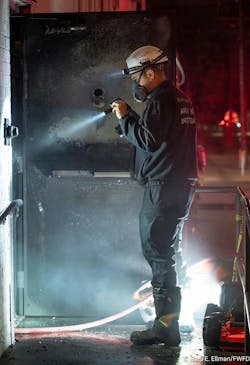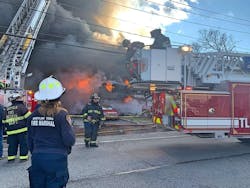Note: This article is part of the Firehouse 2024 Cancer Awareness and Prevention Supplement. To read the entire supplement, click here.
Fire investigators play a critical role in determining the origin and cause of fires via scene examination, scene reconstruction and collection of evidence, among other practices. However, in doing so, they regularly are exposed to dangerous carcinogens that are present in post-fire environments. Like firefighters, these professionals are at a high risk of occupational exposure to harmful substances, which can lead to long-term health issues, including cancer.
Although awareness about protecting firefighters has increased significantly, it’s crucial to extend similar protections to fire investigators to safeguard their health and well-being.
A hidden hazard
When materials burn, they release a complex mixture of toxic chemicals and carcinogens into the air. Benzene, formaldehyde, polycyclic aromatic hydrocarbons (PAHs), asbestos and other substances are common in post-fire environments. These carcinogens settle on surfaces, debris and even investigative tools.
Fire investigators often work in close proximity to these substances. Even after the fire is extinguished, the dangers remain in the air, soot and ash that fire investigators encounter.
Fire investigators face several specific risks:
- Inhalation of airborne toxins. Despite fires being extinguished, smoldering debris can continue to release harmful gases and particles.
- Skin absorption. Carcinogens can be absorbed through exposed skin, particularly when fire investigators handle soot-laden materials without proper protection.
- Contamination of PPE. Reusing contaminated PPE without proper cleaning protocols can lead to repeated exposure.
Fire investigators might arrive on scene prior to a fire’s extinguishment or days later to conduct their investigation and can be on scene for a few hours or multiple days. They often are exposed to the same or similar environments to which firefighters are exposed but for much longer periods of time with much less protection.
UL’s Fire Safety Research Institute (FSRI) conducted experiments to show how risks evolve during fires and in post-fire scenes. FSRI’s research shows that exposure limits for hazardous airborne particulates and gases are exceeded even five days after a fire is extinguished.
Given these hazards, fire investigators must adopt strict safety measures to protect themselves from occupational exposure to carcinogens.
Best practices
Use of proper PPE is the first line of defense for protecting fire investigators against exposure to carcinogens. Fire investigators should wear:
- Respiratory protection. A full-face respirator or SCBA should be used by fire investigators whenever they enter the fire scene. This is particularly true when they enter areas that have visible soot or debris.
- Turnout gear or coveralls. Fire investigators should wear turnout gear or disposable coveralls that are resistant to contamination. Clothing should cover the body fully. Gloves, boots and eye protection also should be worn.
- Gloves. Chemical-resistant gloves should be worn to prevent direct skin contact with soot, debris and contaminated surfaces.
- On-site decon. Before leaving the scene, fire investigators should use decon wipes to clean exposed skin and gear. Soot and particulate matter can cling to clothing and skin, so initial decon at the scene is critical.
- Proper gear cleaning. PPE and clothing should be cleaned immediately after use. Laundering gear in designated facilities separate from regular clothing is essential to prevent cross-contamination.
- Respirator cleaning. Respirators and face masks should be cleaned and disinfected after each use for the purpose of avoiding residual exposure.
Avoiding cross-contamination
Fire investigators often travel between scenes, offices and homes. To minimize cross-contamination:
- Separate work and personal items. Keep all contaminated gear and tools in separate bags or containers and never transport them in personal vehicles without proper storage.
- Shower immediately after work on scene. Investigators should shower and change into clean clothes as soon as possible after they leave the scene to remove any remaining contaminants.
Limiting time on scene
Fire investigators should limit their time in contaminated areas as much as possible. This might involve:
- Thorough scene assessment planning. Before entering the fire scene, assess it from a distance and plan investigation steps efficiently to minimize exposure time.
- Use of technology. Whenever possible, use drones, remote cameras or other investigative technologies to gather evidence without prolonged physical presence in hazardous areas.
Training and awareness
Ongoing education is key to ensuring that fire investigators understand the risks and are equipped to protect themselves.
- Health and safety training. Regular training sessions on occupational health hazards and PPE usage can ensure that investigators are up to date with best practices.
- Awareness of evolving threats. As building materials and fire dynamics evolve, so, too, do the types of carcinogens that are encountered on the fireground. Investigators should stay informed about new chemical hazards and adjust safety protocols accordingly.
Post-fire air monitoring
Investigators should work with departments to ensure that post-fire air quality monitoring is in place.
- Air sampling. Using portable air quality monitors to check for volatile organic compounds (VOCs) and other hazardous substances can provide critical information about the safety of a fire scene.
- Clearing hot spots. Avoid working in areas that have smoldering debris until the scene is confirmed safe by environmental monitoring.
Institutional support
Ensuring that fire investigators have the tools, resources and support to protect themselves isn’t just an individual responsibility but an organizational one. Fire departments and investigative agencies should:
- Provide necessary PPE and training. Departments should supply fire investigators with appropriate PPE, including respiratory protection, coveralls and decon materials.
- Implement safety protocols. Establishing clear guidelines for PPE use, decon and air monitoring can protect investigators from avoidable exposure.
- Support health monitoring. Regular health screenings and medical checkups for investigators can help in the early detection of potential health issues that are related to carcinogen exposure.
Be proactive
Protecting fire investigators from carcinogens is essential but often overlooked. By adopting comprehensive protective measures, including the use of PPE, decon protocols and limiting time on scene, fire investigators can reduce their risk of exposure to harmful substances significantly. With institutional support, proper training and a commitment to best practices, fire investigators can continue to perform their critical duties while safeguarding their long-term health and well-being.
Proactive measures that fire investigators take today can lead to a healthier, longer career and retirement.
To learn more on this topic, see NFPA 921: Guide for Fire and Explosion Investigations, NFPA 1033: Standard for Professional Qualifications for Fire Investigator, NFPA 1585: Standard for Exposure and Contamination Control and FSRI’s “Post-Fire Chemical Exposure Risks to Fire Investigators”.
About the Author

Jessica HIll
Jessica Hill has been a volunteer firefighter for the East Farmingdale, NY, Volunteer Fire Company since 2013. She has been a career fire marshal for the town of Babylon, NY, since 2018. Hill has a bachelor’s degree in fire science and a bachelor’s degree in criminal justice, both from the University of New Haven.

